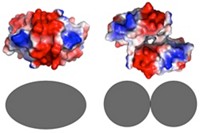Advertisement
Grab your lab coat. Let's get started
Welcome!
Welcome!
Create an account below to get 6 C&EN articles per month, receive newsletters and more - all free.
It seems this is your first time logging in online. Please enter the following information to continue.
As an ACS member you automatically get access to this site. All we need is few more details to create your reading experience.
Not you? Sign in with a different account.
Not you? Sign in with a different account.
ERROR 1
ERROR 1
ERROR 2
ERROR 2
ERROR 2
ERROR 2
ERROR 2
Password and Confirm password must match.
If you have an ACS member number, please enter it here so we can link this account to your membership. (optional)
ERROR 2
ACS values your privacy. By submitting your information, you are gaining access to C&EN and subscribing to our weekly newsletter. We use the information you provide to make your reading experience better, and we will never sell your data to third party members.
Analytical Chemistry
Complex Shapes up
Method reveals shape and stoichiometry of a protein complex in single experiment
by Celia Henry Arnaud
November 21, 2005
| A version of this story appeared in
Volume 83, Issue 47
Structural Biology
By combining ion mobility measurements and mass spectrometry, researchers have obtained information about a protein complexs shape and stoichiometry from a single analysis of the complex in the gas phase (Science, published online Nov. 17, dx.doi.org/10.1126/science.1120177).
The technique is based on the ability of protein complexes to maintain their shapes in the gas phase and yields information about the solution structure that is otherwise difficult to obtain. It offers new possibilities for exploring protein structure in heterogeneous complexes, an area of structural biology that has not been accessible until now, says University of Cambridge chemistry professor Carol V. Robinson, the studys lead author.
David E. Clemmer, a chemistry professor at Indiana University and a pioneer in the combination of ion mobility and mass spectrometry, says, The ability to rapidly assess the shapes of protein assemblies by mass spectrometry will open up many new approaches for understanding higher order structure.
It is known that some elements of a proteins 3-D structure in water can be transferred to the dehydrating environment of vacuum, says Joseph A. Loo, professor of biochemistry and biological chemistry at the University of California, Los Angeles. The current study is unique, he adds, because it features a highly structured shape, an 11-membered nearly circular ring, for such a large protein complex.
Robinson and postdoctoral researcher Brandon Ruotolo, with coworkers at Cambridge and at Waters MS Technologies Center in Manchester, England, demonstrate the technique with trp RNA-binding attenuation protein (TRAP) and show that assemblies of the complex maintain their topology in the gas phase. The complex consists of a ring of 11 identical subunits, each bound to tryptophan. A 53-nucleotide strand of messenger RNA binds the perimeter of the complex.

The researchers thought that the circular arrangement would allow them to detect changes easily if the complex collapsed as the solvent was removed. We knew that in the absence of the specific RNA or tryptophan molecules, TRAP is very fragile and therefore would most likely change its shape or collapse, Robinson says. The changes allowed us to probe differences in the shape of the complex.
Robinson was surprised that even without the RNA and tryptophan (the so-called apo form of the complex), the gas-phase structure was close to the calculated crystal structure. I had always hoped this would be the case but had never been able to prove it directly until now, she says.
At only 91 kilodaltons, TRAP is not particularly large, but unpublished results from Robinsons lab suggest that the method will work just as well for much larger complexes. I dont think there will be an upper size limit beyond which gas-phase structure will no longer be indicative of what is going on in solution, Robinson says.
Robinsons work shows what many of us have long suspected—that much of a proteins ordered arrangement that exists in an aqueous environment can be maintained in the absence of water, Loo says. How much of a proteins structure in water is reflected in its gas-phase molecule is a question that still needs to be addressed.





Join the conversation
Contact the reporter
Submit a Letter to the Editor for publication
Engage with us on Twitter